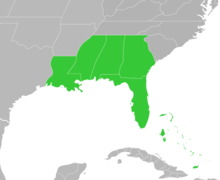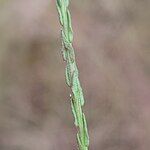Symphyotrichum adnatum
| Symphyotrichum adnatum | |
|---|---|

| |
| Scientific classification | |
| Kingdom: | Plantae |
| Clade: | Tracheophytes |
| Clade: | Angiosperms |
| Clade: | Eudicots |
| Clade: | Asterids |
| Order: | Asterales |
| Family: | Asteraceae |
| Tribe: | Astereae |
| Subtribe: | Symphyotrichinae |
| Genus: | Symphyotrichum |
| Subgenus: | Symphyotrichum subg. Virgulus |
| Section: | Symphyotrichum sect. Patentes |
| Species: | S. adnatum
|
| Binomial name | |
| Symphyotrichum adnatum | |

| |
| Native distribution[2] | |
| Synonyms[2] | |
Symphyotrichum adnatum (formerly Aster adnatus) is a species of flowering plant in the family Asteraceae native to the southeastern United States and the Bahamas. It is a perennial, herbaceous plant that may reach 30 to 120 centimeters (1 to 4 feet) tall with flowers that have lavender ray florets and yellow disk florets. The common name scaleleaf aster has been used for this species.
Description
[edit]Symphyotrichum adnatum is a perennial, herbaceous, cespitose flowering plant that may reach heights between 30 and 120 centimeters (1 and 4 feet). Each plant has five or more brown hairy stems that can grow erect or sprawling. The stems have thick and firm yellow-green leaves with smooth margins. It blooms from October into December with flowers that have 10–20 dark lavender ray florets and 12–25 yellow disk florets.[3]
-
Involucre and phyllaries
-
Close-up of ray and disk florets
-
Flower heads after seeding
Taxonomy
[edit]The species' basionym (original scientific name) is Aster adnatus Nutt., and it has three other taxonomic synonyms. Its name with author citations is Symphyotrichum adnatus (Nutt.) G.L.Nesom,[2] and a common name scaleleaf aster has been used for it.[3] Within family Asteraceae, tribe Astereae, it is a member of the genus Symphyotrichum and subgenus Virgulus, placed in section Patentes,[4] subsection Brachyphylli, where it exists with its sister species S. walteri.[5]
-
Symphyotrichum subg. Chapmaniana (1 species)
subg. Astropolium (11 species)
subg. Virgulus sect. Ericoidei sect. Patentes subsect. Brachyphylli subsect. Patentes sect. Grandiflori subsect. Mexicanae subsect. Grandiflori sect. Polyliguli sect. Concolores subg. Ascendentes (2 species)
subg. Symphyotrichum (55 species)
Distribution and habitat
[edit]S. adnatum is native to the Bahamas and the southeastern United States, including Alabama, Florida, Georgia, Louisiana, and Mississippi.[2] It grows at elevations up to 100 meters (330 feet) in scrubland and woodland with sandy soils.[3]
Conservation
[edit]As of October 2024[update], NatureServe listed Symphyotrichum adnatum as Apparently Secure (G4) worldwide. The status was last reviewed 2 May 1988.[1]
Citations
[edit]- ^ a b NatureServe 2024.
- ^ a b c d e POWO 2024.
- ^ a b c Brouillet et al. 2006.
- ^ Brouillet et al. 2006a.
- ^ Nesom 1994, p. 274.
References
[edit]- Brouillet, L.; Semple, J.C.; Allen, G.A.; Chambers, K.L.; Sundberg, S.D. (2006). "Symphyotrichum adnatum". In Flora of North America Editorial Committee (ed.). Flora of North America North of Mexico (FNA). Vol. 20. New York and Oxford: Oxford University Press. Retrieved 11 July 2021 – via eFloras.org, Missouri Botanical Garden, St. Louis, MO & Harvard University Herbaria, Cambridge, MA.
- Brouillet, L.; Semple, J.C.; Allen, G.A.; Chambers, K.L.; Sundberg, S.D. (2006a). "Symphyotrichum subg. Virgulus". In Flora of North America Editorial Committee (ed.). Flora of North America North of Mexico (FNA). Vol. 20. New York and Oxford: Oxford University Press. Retrieved 23 October 2024 – via eFloras.org, Missouri Botanical Garden, St. Louis, MO & Harvard University Herbaria, Cambridge, MA.
- NatureServe (4 October 2024). "Symphyotrichum adnatum Scaleleaf Aster". explorer.natureserve.org. Arlington, Virginia. Retrieved 22 October 2024.
- Nesom, G.L. (September 1994). "Review of the taxonomy of Aster sensu lato (Asteraceae: Astereae), emphasizing the New World species". Phytologia. 77 (3) (published 31 January 1995): 141–297. ISSN 0031-9430. Retrieved 23 August 2021 – via Biodiversity Heritage Library.
- POWO (2024). "Symphyotrichum adnatum (Nutt.) G.L.Nesom". Plants of the World Online. Royal Botanic Gardens, Kew. Retrieved 22 October 2024.







